Technogenic Fiber Wastes for Optimizing Concrete
Abstract
1. Introduction
- −
- increase in the crack resistance of the product (resistance to shrinkage and operational cracks);
- −
- imparting thixotropic properties of the mortars;
- −
- improving the fixing ability on a vertical surface, preventing tiles from slipping (if in tile adhesive);
- −
- reduction in shrinkage that occurs during the maturation of mortar or concrete;
- −
- increase in frost-resistant properties of products;
- −
- improving the rheological properties of the mortar and increasing the time of work with them.
2. Materials and Methods
2.1. Materials
2.2. Mix Design
2.3. Methods
3. Results and Discussion
3.1. Comprehensive Study of the Technogenic Fibrous Material
3.2. Properties of Concrete with TFM
4. Conclusions
- −
- The processing of TFM for 10 min leads to the grinding of not only fibers, but also granules, fragments of which are noticeable in the total mass of the substance. There is a large amount of the smallest nanosized crushed fractions, however, there is also a significant amount of larger particles of a fibrous form. This is the reason for the effective use of the material to control the structure formation of the cement composite, both at the macro level (fiber) and at the micro level (cement substitute).
- −
- The reactive activity of TFM is confirmed by the high solubility in saturated alkaline solutions of the hydrated binder and active interaction with the Ca(OH)2 released as a result of the hydration of clinker minerals. These processes make it possible to purposefully synthesize low-basic calcium silicate hydrates during hydration, which are responsible for the strength properties of the finished building product.
- −
- At 90 days of age, at 10–20% of the content of TFM, the strength indicators increase (above 40 MPa), and at 30% of the additive content, they approach the values of the control composition without additives (above 35 MPa). For all ages, the ratio of flexural and compressive strengths is at the level of 0.2, which characterizes a high reinforcing effect. The increase in strength may be associated with the pozzolanic reaction, the completeness of which increases most at a later age. In addition, the microsize of the grains of TFM waste used in this study increases the compressive strength of the mortar by acting as a compactor.
- −
- Analysis of the results suggests the possibility of using waste milled for 10 min as an active mineral additive, as well as to give better moldability to the mixture and its micro-reinforcement to obtain fiber-reinforced concrete.
Author Contributions
Funding
Institutional Review Board Statement
Informed Consent Statement
Data Availability Statement
Acknowledgments
Conflicts of Interest
References
- Fediuk, R.S.; Yushin, A.M. The use of fly ash the thermal power plants in the construction. IOP Conf. Ser. Mater. Sci. Eng. 2015, 93, 012070. [Google Scholar] [CrossRef]
- Lesovik, V.S. The reducing effect of argon in the plasma treatment of high-melting nonmetallic materials (a review). Glass Ceram. 2001, 58, 362–364. [Google Scholar]
- Jabir, H.A.; Abid, S.R.; Murali, G.; Ali, S.H.; Klyuev, S.; Fediuk, R.; Vatin, N.; Promakhov, V.; Vasilev, Y. Experimental tests and reliability analysis of the cracking impact resistance of UHPFRC. Fibers 2020, 8, 74. [Google Scholar] [CrossRef]
- Mousavi, M.A.; Sadeghi-Nik, A.; Bahari, A.; Ashour, A.; Khayat, K.H. Cement paste modified by nano-montmorillonite and carbon nanotubes. ACI Mater. J. 2022, 119, 173–185. [Google Scholar] [CrossRef]
- Dabbaghi, F.; Sadeghi-Nik, A.; Libre, N.A.; Nasrollahpour, S. Characterizing fiber reinforced concrete incorporating zeolite and metakaolin as natural pozzolans. Structures 2021, 34, 2617–2627. [Google Scholar] [CrossRef]
- Makul, N.; Fediuk, R.; Amran, M.; Zeyad, A.M.; Murali, G.; Vatin, N.; Klyuev, S.; Ozbakkaloglu, T.; Vasilev, Y. Use of recycled concrete aggregates in production of green cement-based concrete composites: A review. Crystals 2021, 11, 232. [Google Scholar] [CrossRef]
- Loganina, V.; Sergeeva, K.; Fediuk, R.; Uvarov, V.; Vatin, N.; Vasilev, Y.; Amran, M.; Szelag, M. Increase the performances of lime finishing mixes due to modification with calcium silicate hydrates. Crystals 2021, 11, 399. [Google Scholar] [CrossRef]
- Usanova, K.; Barabanshchikov, Y.G. Cold-bonded fly ash aggregate concrete. Mag. Civ. Eng. 2020, 3, 104–118. [Google Scholar] [CrossRef]
- Kharun, M.; Klyuev, S.; Koroteev, D.; Chiadighikaobi, P.C.; Fediuk, R.; Olisov, A.; Vatin, N.; Alfimova, N. Heat treatment of basalt fiber reinforced expanded clay concrete with increased strength for cast-in-situ construction. Fibers 2020, 8, 67. [Google Scholar] [CrossRef]
- Fediuk, R.S.; Smoliakov, A.K.; Timokhin, R.A.; Batarshin, V.O.; Yevdokimova, Y.G. Using thermal power plants waste for building materials. IOP Conf. Ser. Earth Environ. Sci. 2018, 87, 092010. [Google Scholar] [CrossRef]
- Loganina, V.I.; Frolov, M.V.; Skachkov, Y.P. Lime composition for the walls of buildings made of aerated concrete. In Proceedings of the 2016 International Symposium on Mechanical Engineering and Material Science (ISMEMS 2016), Jeju Island, Korea, 17–19 November 2016; Atlantis Press: Dordrecht, The Netherlands, 2016. [Google Scholar]
- Fediuk, R.; Timokhin, R.; Mochalov, A.; Otsokov, K.; Lashina, I. Performance properties of high-density impermeable cementitious paste. J. Mater. Civ. Eng. 2019, 31, 04019013. [Google Scholar] [CrossRef]
- Wang, B.; Li, K.; Nan, D.; Feng, S.; Hu, B.; Wang, T.; Lu, Q. Enhanced production of levoglucosenone from pretreatment assisted catalytic pyrolysis of waste paper. J. Anal. Appl. Pyrolysis 2022, 165, 105567. [Google Scholar] [CrossRef]
- Lukuttsova, N. Water films (nanofilms) in cement concrete deformations. Int. J. Appl. Eng. Res. 2015, 10, 35120–35124. [Google Scholar]
- Kolesnikov, A.S. Kinetic investigations into the distillation of nonferrous metals during complex processing of waste of metallurgical industry. Russ. J. Non-Ferr. Met. 2015, 56, 1–5. [Google Scholar] [CrossRef]
- Chakrawarthi, V.; Dharmar, B.; Avudaiappan, S.; Amran, M.; Flores, E.S.; Alam, M.A.; Rashid, R.S. Destructive and non-destructive testing of the performance of copper slag fiber-reinforced concrete. Materials 2022, 15, 4536. [Google Scholar] [CrossRef]
- Ibragimov, R.A.; Korolev, E.V.; Deberdeev, T.R.; Leksin, V.V. Efficient complex activation of Portland cement through processing it in the vortex layer machine. Struct. Concr. 2019, 20, 851–859. [Google Scholar] [CrossRef]
- Saidumov, M.S.; Murtazaeva, T.-A.; Salamanova, M.S.; Alaskhanov, A.K.; Ismailova, Z.K.; Saidumov, M.S. Water-reducing and plasticizing additives for highly mobile concrete mixtures. In Proceedings of the International Symposium “Engineering and Earth Sciences: Applied and Fundamental Research” Dedicated to the 85th Anniversary of H.I. Ibragimov (ISEES 2019), Grozny, Russia, 10–13 June 2019; Atlantis Press: Dordrecht, The Netherlands, 2019. [Google Scholar]
- Amran, M.; Fediuk, R.; Murali, G.; Avudaiappan, S.; Ozbakkaloglu, T.; Vatin, N.; Karelina, M.; Klyuev, S.; Gholampour, A. Fly ash-based eco-efficient concretes: A comprehensive review of the short-term properties. Materials 2021, 14, 4264. [Google Scholar] [CrossRef]
- Fediuk, R.S.; Lesovik, V.S.; Mochalov, A.V.; Otsokov, K.A.; Lashina, I.V.; Timokhin, R.A. Composite binders for concrete of protective structures. Mag. Civ. Eng. 2018, 82, 208–218. [Google Scholar]
- Ali, M.; Abbas, S.; Khan, M.I.; Anwar Gad, M.; Ammad, S.; Khan, A. Experimental validation of Mander’s model for low strength confined concrete under axial compression. In Proceedings of the 2020 Second International Sustainability and Resilience Conference: Technology and Innovation in Building Designs (51154), Sakheer, Bahrain, 11–12 November 2020; pp. 1–6. [Google Scholar]
- Zaleska, M.; Pavlikova, M.; Pavlik, Z.; Jankovsky, O.; Pokorny, J.; Tydlitat, V.; Svora, P.; Cerny, R. Physical and chemical characterization of technogenic pozzolans for the application in blended cements. Constr. Build. Mater. 2018, 160, 106–116. [Google Scholar] [CrossRef]
- Rudenko, A.; Biryukov, A.; Kerzhentsev, O.; Fediuk, R.; Vatin, N.; Vasilev, Y.; Klyuev, S.; Amran, M.; Szelag, M. Nano- and Micro-modification of building reinforcing bars of various types. Crystals 2021, 11, 323. [Google Scholar] [CrossRef]
- Korsun, V.; Vatin, N.; Korsun, A.; Nemova, D. Physical-mechanical properties of the modified fine-grained concrete subjected to thermal effects up to 200 °C. In Proceedings of the 4th International Conference on Advanced Design and Manufacturing Engineering (ADME 2014), Hangzhou, China, 26–27 July 2014. [Google Scholar]
- Tolstoy, A.; Lesovik, V.; Fediuk, R.; Amran, M.; Gunasekaran, M.; Vatin, N.; Vasilev, Y. Production of greener high-strength concrete using Russian quartz sandstone mine waste aggregates. Materials 2020, 13, 5575. [Google Scholar] [CrossRef] [PubMed]
- Ivanovna, L.V.; Vladimirovna, Z.C. The effectiveness of use of the composite binder as a dry mix. Case Stud. Constr. Mater. 2015, 3, 137–140. [Google Scholar] [CrossRef][Green Version]
- Lukuttsova, N.; Pykin, A.; Kleymenicheva, Y.; Suglobov, A.; Efremochkin, R. Nano-additives for composite building materials and their environmental safety. Int. J. Appl. Eng. Res. 2016, 11, 7561–7565. [Google Scholar]
- Kolesnikov, A.S.; Kenzhibaeva, G.S.; Botabaev, N.E.; Kutzhanova, A.N.; Iztleuov, G.M.; Suigenbaeva, A.Z.; Ashirbekov, K.A.; Kolesnikova, O.G. Thermodynamic modeling of chemical and phase transformations in a Waelz process-slag–carbon system. Refract. Ind. Ceram. 2020, 61, 289–292. [Google Scholar] [CrossRef]
- Stroganov, V.; Sagadeev, E.; Ibragimov, R.; Potapova, L. Mechanical activation effect on the biostability of modified cement compositions. Constr. Build. Mater. 2020, 246, 118506. [Google Scholar] [CrossRef]
- Smirnova, O. Compatibility of shungisite microfillers with polycarboxylate admixtures in cement compositions. ARPN J. Eng. Appl. Sci. 2019, 14, 600–610. [Google Scholar]
- Fediuk, R.; Smoliakov, A.; Stoyushko, N. Increase in composite binder activity. IOP Conf. Ser. Mater. Sci. Eng. 2016, 156, 012042. [Google Scholar] [CrossRef]
- Lesovik, V.S.; Zagorodnyuk, L.K.; Babaev, Z.K.; Dzhumaniyazov, Z.B. Analysis of the causes of brickwork efflorescence in the Aral Sea region. Glas. Ceram. 2020, 77, 277–279. [Google Scholar] [CrossRef]
- Amran, M.; Murali, G.; Khalid, N.H.A.; Fediuk, R.; Ozbakkaloglu, T.; Lee, Y.H.; Haruna, S.; Lee, Y.Y. Slag uses in making an ecofriendly and sustainable concrete: A review. Constr. Build. Mater. 2021, 272, 121942. [Google Scholar] [CrossRef]
- Tolstoy, A.D.; Lesovik, V.S.; Glagolev, E.S.; Krymova, A.I. Synergetics of hardening construction systems. IOP Conf. Ser. Mater. Sci. Eng. 2018, 327, 032056. [Google Scholar] [CrossRef]
- Mukhametrakhimov, R.; Galautdinov, A.; Garafiev, A. The concrete modified by conductive mineral for electrode heating. IOP Conf. Ser. Mater. Sci. Eng. 2020, 890, 012124. [Google Scholar] [CrossRef]
- Wang, D.; Ju, Y.; Shen, H.; Xu, L. Mechanical properties of high performance concrete reinforced with basalt fiber and polypropylene fiber. Constr. Build. Mater. 2019, 197, 464–473. [Google Scholar] [CrossRef]
- Raza, S.S.; Qureshi, L.A.; Ali, B.; Raza, A.; Khan, M.M. Effect of different fibers (steel fibers, glass fibers, and carbon fibers) on mechanical properties of reactive powder concrete. Struct. Concr. 2020, 22, 334–346. [Google Scholar] [CrossRef]
- Amiri, H.; Azadi, S.; Karimaei, M.; Sadeghi, H.; Dabbaghi, F. Multi-objective optimization of coal waste recycling in concrete using response surface methodology. J. Build. Eng. 2022, 45, 103472. [Google Scholar] [CrossRef]
- Dabbaghi, F.; Fallahnejad, H.; Nasrollahpour, S.; Dehestani, M.; Yousefpour, Y. Evaluation of fracture energy, toughness, brittleness, and fracture process zone properties for lightweight concrete exposed to high temperatures. Theor. Appl. Fract. Mech. 2021, 116, 103088. [Google Scholar] [CrossRef]
- Klyuyev, S.V.; Guryanov, Y.V. External reinforcing of fiber concrete constructions by carbon fiber tapes. Mag. Civ. Eng. 2013, 36, 21–26. [Google Scholar] [CrossRef]
- Mukhametrakhimov, R.; Lukmanova, L. Investigation of Portland cement in 3D concrete printing. Lect. Notes Civ. Eng. 2021, 169, 1–13. [Google Scholar]
- Galautdinov, A.; Mukhametrakhimov, R.; Kupriyanov, V. Gypsum-fiber radioprotective facing materials. Lect. Notes Civ. Eng. 2021, 169, 372–381. [Google Scholar]
- Klyuev, S.V.; Khezhev, T.A.; Pukharenko, Y.V.; Klyuev, A.V. To the question of fiber reinforcement of concrete. Mater. Sci. Forum 2018, 945, 25–29. [Google Scholar] [CrossRef]
- Klyuev, S.V.; Bratanovskiy, S.N.; Trukhanov, S.V.; Manukyan, H.A. Strengthening of concrete structures with composite based on carbon fiber. J. Comput. Theor. Nanosci. 2019, 16, 2810–2814. [Google Scholar] [CrossRef]
- Fediuk, R.; Mugahed Amran, Y.H.; Mosaberpanah, M.A.; Danish, A.; El-Zeadani, M.; Klyuev, S.V.; Vatin, N. A critical review on the properties and applications of sulfur-based concrete. Materials 2020, 13, 4712. [Google Scholar] [CrossRef] [PubMed]
- Klyuev, S.V.; Khezhev, T.A.; Pukharenko, Y.V.; Klyuev, A.V. Fibers and their properties for concrete reinforcement. Mater. Sci. Forum 2018, 945, 125–130. [Google Scholar] [CrossRef]
- Mukhametrakhimov, R.K.; Lukmanova, L.V.; Khuzin, A.F. Investigation of the influence of organosilicon compounds on fiber cement panels’ characteristics. IOP Conf. Ser. Earth Environ. Sci. 2017, 90, 012132. [Google Scholar] [CrossRef]
- Klyuev, S.V.; Khezhev, T.A.; Pukharenko, Y.V.; Klyuev, A.V. Fiber concrete for industrial and civil construction. Mater. Sci. Forum 2018, 945, 120–124. [Google Scholar] [CrossRef]
- Klyuyev, S.V.; Klyuyev, A.V.; Sopin, D.M.; Netrebenko, A.V.; Kazlitin, S.A. Heavy loaded floors based on fine-grained fiber concrete. Mag. Civ. Eng. 2013, 38, 7–14. [Google Scholar] [CrossRef]
- Klyuev, S.V.; Khezhev, T.A.; Pukharenko, Y.V.; Klyuev, A.V. Experimental study of fiber-reinforced concrete structures. Mater. Sci. Forum 2018, 945, 115–119. [Google Scholar] [CrossRef]
- Mukhametrakhimov, R.K.; Galautdinov, A.R.; Gilmanshin, I.R. Modified gypsum-cement-pozzolanic composites reinforced with polypropylene fibers. IOP Conf. Ser. Mater. Sci. Eng. 2019, 570, 012068. [Google Scholar] [CrossRef]
- Begich, Y.E.; Klyuev, S.V.; Jos, V.A.; Cherkashin, A.V. Fine-grained concrete with various types of fibers. Mag. Civ. Eng. 2020, 97, 9702. [Google Scholar] [CrossRef]
- Lukmanova, L.V.; Mukhametrakhimov, R.K.; Gilmanshin, I.R. Investigation of mechanical properties of fiber-cement board reinforced with cellulosic fibers. IOP Conf. Ser. Mater. Sci. Eng. 2019, 570, 012113. [Google Scholar] [CrossRef]
- Karmegam, A.; Avudaiappan, S.; Amran, M.; Guindos, P.; Vatin, N.I.; Fediuk, R. Retrofitting RC beams using high-early strength alkali-activated concrete. Case Stud. Constr. Mater. 2022, 17, e01194. [Google Scholar] [CrossRef]
- Subash, N.; Avudaiappan, S.; Adish Kumar, S.; Amran, M.; Vatin, N.; Fediuk, R.; Aepuru, R. Experimental investigation on geopolymer concrete with various sustainable mineral ashes. Materials 2021, 14, 7596. [Google Scholar] [CrossRef] [PubMed]
- Zeyad, A.M.; Magbool, H.M.; Amran, M.; Mijarsh, M.J.A.; Almalki, A. Performance of high-strength green concrete under the influence of curing methods, volcanic pumice dust, and hot weather. Arch. Civ. Mech. Eng. 2022, 22, 134. [Google Scholar] [CrossRef]
- Amran, M.; Huang, S.S.; Onaizi, A.M.; Murali, G.; Abdelgader, H.S. Fire spalling behavior of high-strength concrete: A critical review. Constr. Build. Mater. 2022, 341, 127902. [Google Scholar] [CrossRef]
- Prakash, R.; Divyah, N.; Srividhya, S.; Avudaiappan, S.; Amran, M.; Naidu Raman, S.; Fediuk, R. Effect of steel fiber on the strength and flexural characteristics of coconut shell concrete partially blended with fly ash. Materials 2022, 15, 4272. [Google Scholar] [CrossRef]
- Danish, A.; Mosaberpanah, M.A.; Salim, M.U.; Amran, M.; Fediuk, R.; Ozbakkaloglu, T.; Rashid, M.F. Utilization of recycled carbon fiber reinforced polymer in cementitious composites: A critical review. J. Build. Eng. 2022, 53, 104583. [Google Scholar] [CrossRef]
- Amran, M.; Huang, S.S.; Debbarma, S.; Rashid, R.S. Fire resistance of geopolymer concrete: A critical review. Constr. Build. Mater. 2022, 324, 126722. [Google Scholar] [CrossRef]
- Mubarak, M.; Muhammad Rashid, R.S.; Amran, M.; Fediuk, R.; Vatin, N.; Klyuev, S. Mechanical properties of high-performance hybrid fibre-reinforced concrete at elevated temperatures. Sustainability 2021, 13, 13392. [Google Scholar] [CrossRef]
- Lesovik, V.; Fediuk, R.; Amran, M.; Alaskhanov, A.; Volodchenko, A.; Murali, G.; Elistratkin, M. 3D-printed mortars with combined steel and polypropylene fibers. Fibers 2021, 9, 79. [Google Scholar] [CrossRef]
- Chakrawarthi, V.; Avudaiappan, S.; Amran, M.; Dharmar, B.; Raj Jesuarulraj, L.; Fediuk, R.; Saavedra Flores, E. Impact resistance of polypropylene fibre-reinforced alkali–activated copper slag concrete. Materials 2021, 14, 7735. [Google Scholar] [CrossRef]
- Amran, M.; Fediuk, R.; Abdelgader, H.S.; Murali, G.; Ozbakkaloglu, T.; Lee, Y.H.; Lee, Y.Y. Fiber-reinforced alkali-activated concrete: A review. J. Build. Eng. 2022, 45, 103638. [Google Scholar] [CrossRef]
- Amran, M.; Al-Fakih, A.; Chu, S.H.; Fediuk, R.; Haruna, S.; Azevedo, A.; Vatin, N. Long-term durability properties of geopolymer concrete: An in-depth review. Case Stud. Constr. Mater. 2021, 15, e00661. [Google Scholar] [CrossRef]

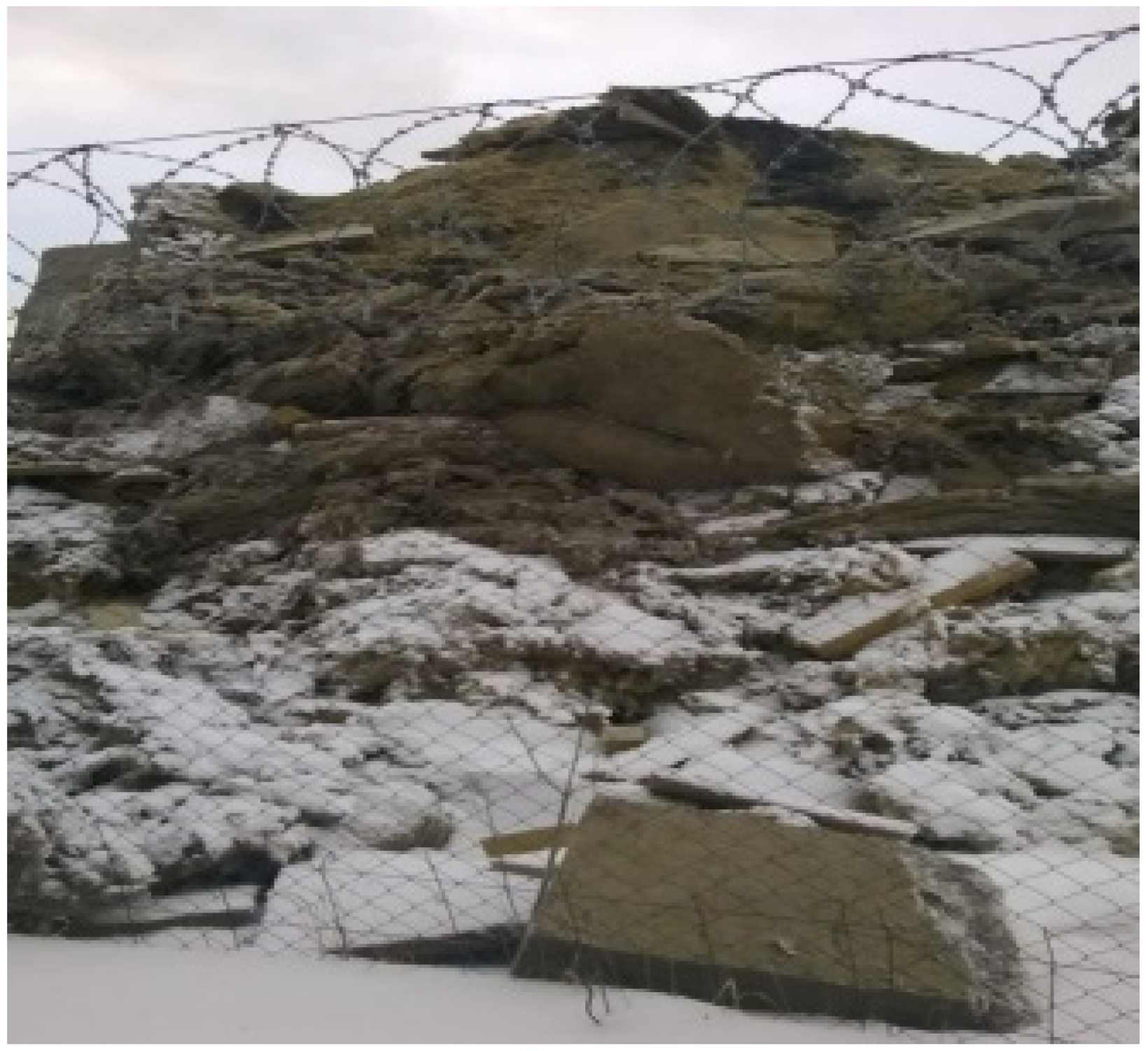
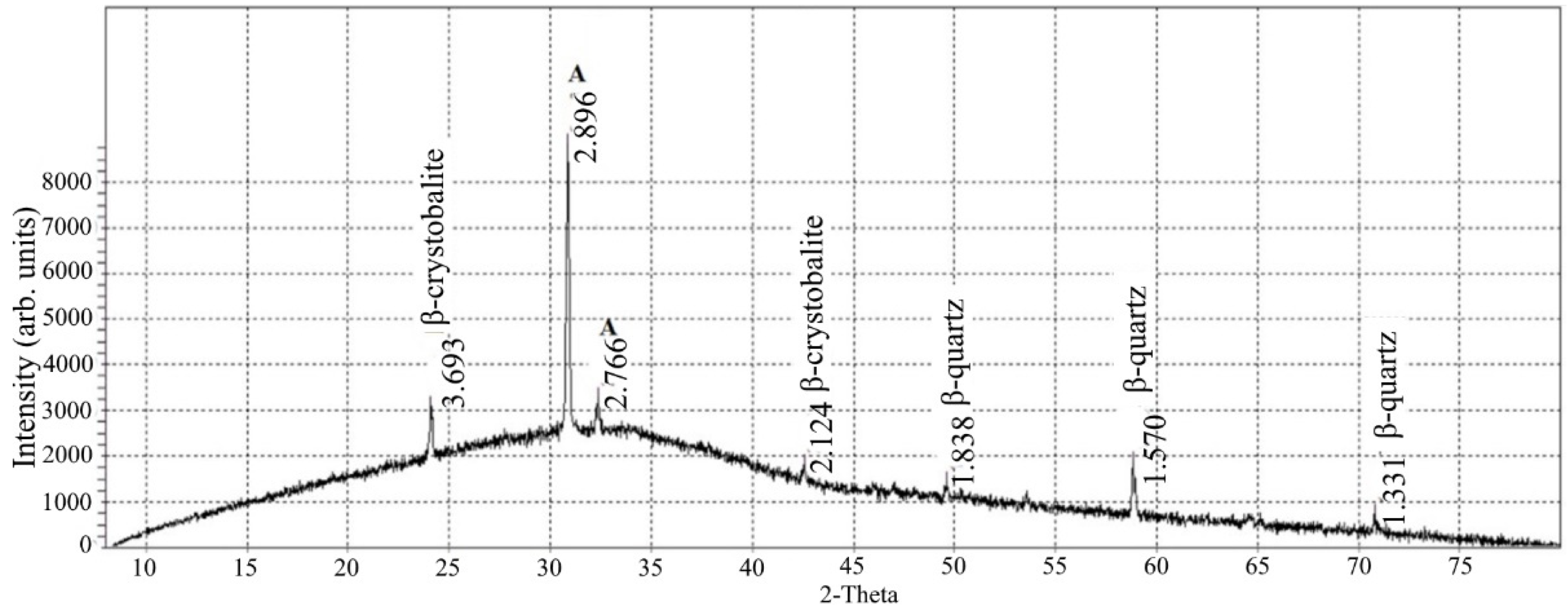

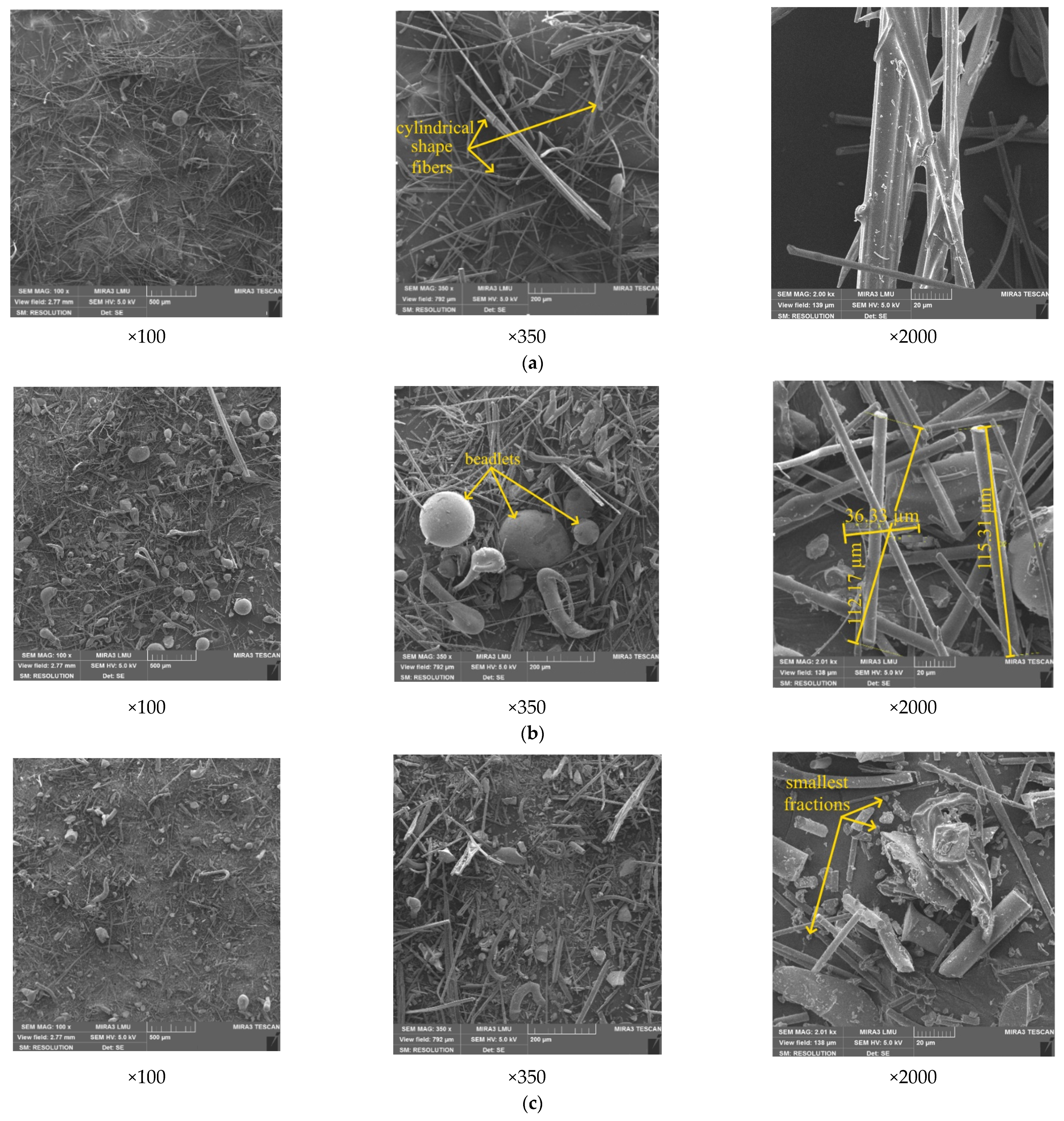
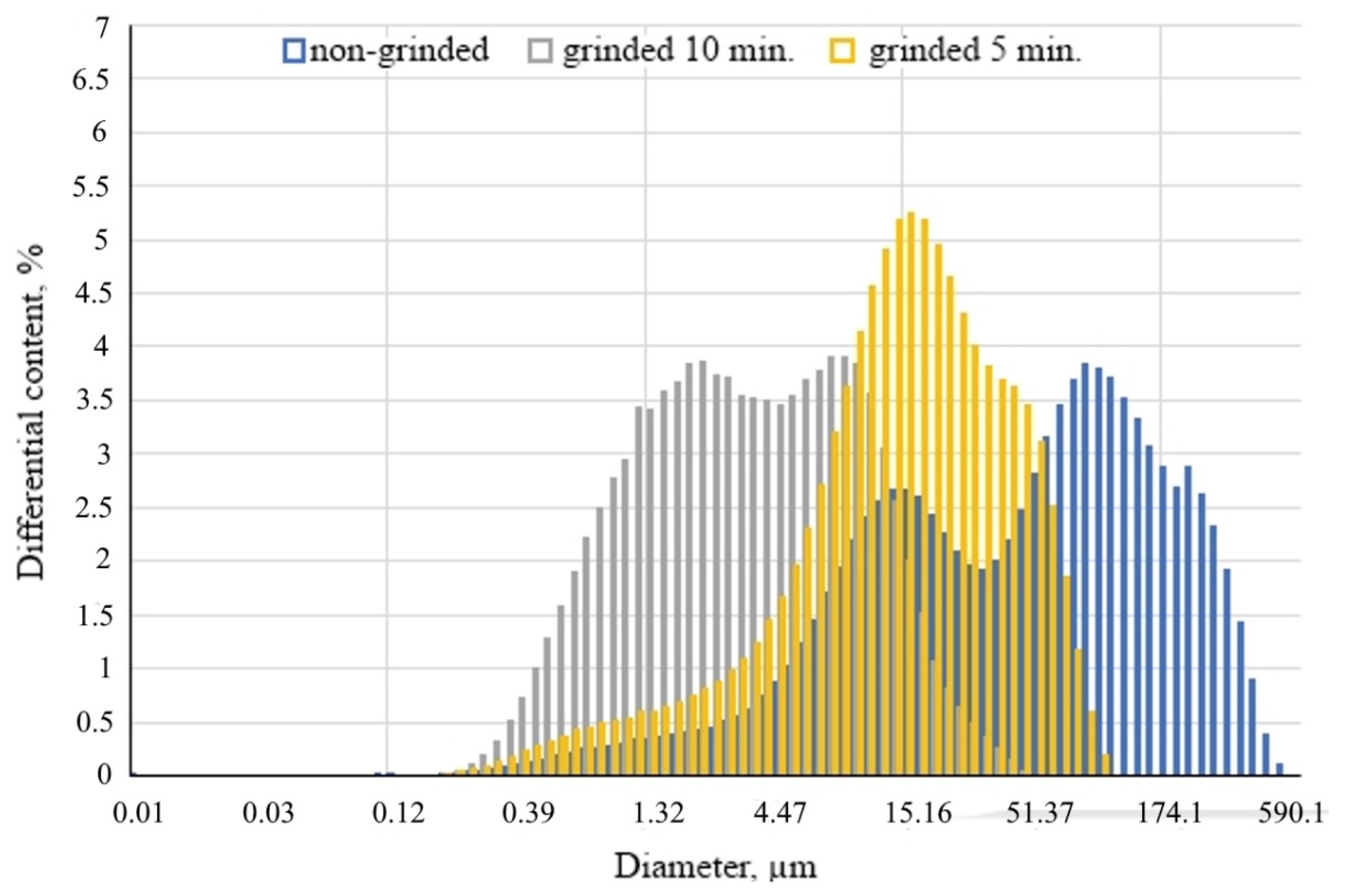
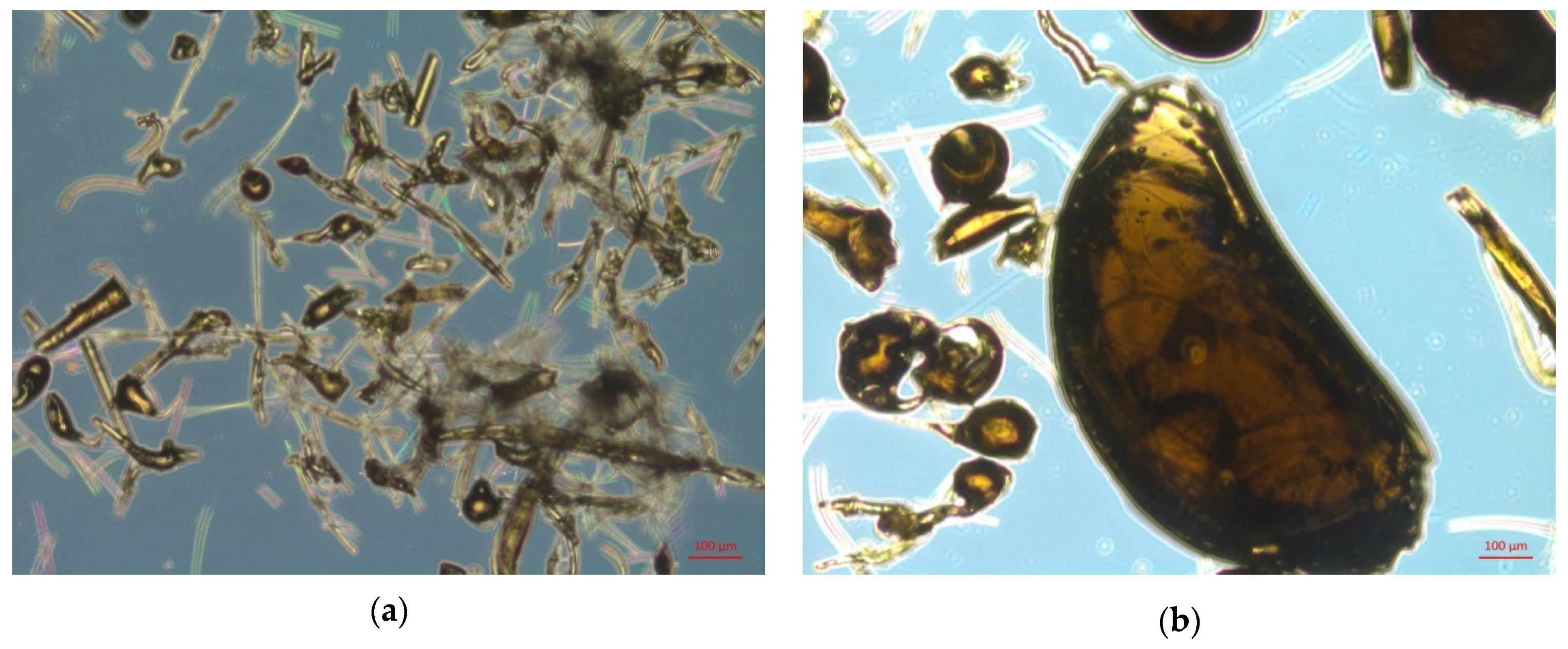
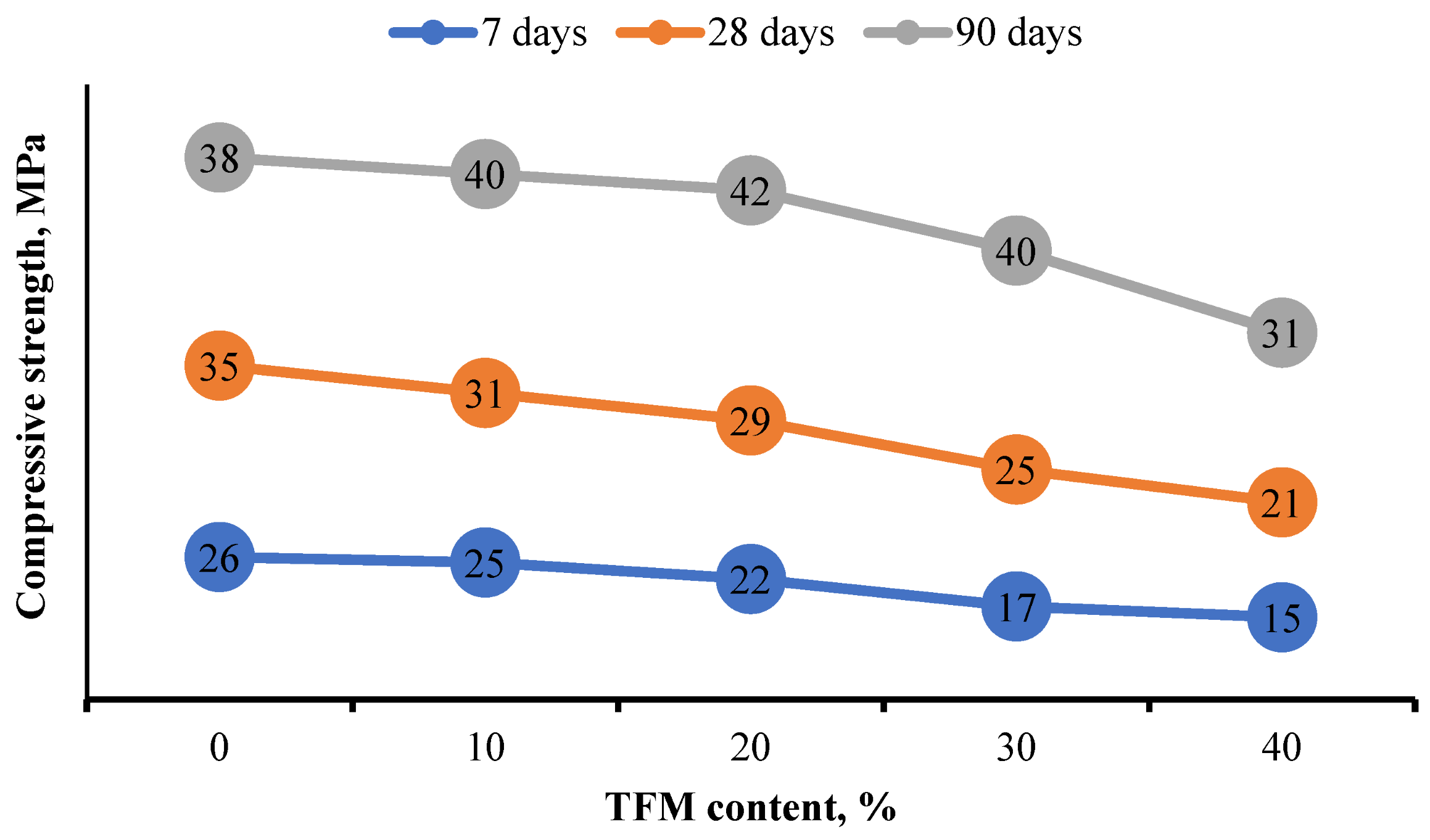
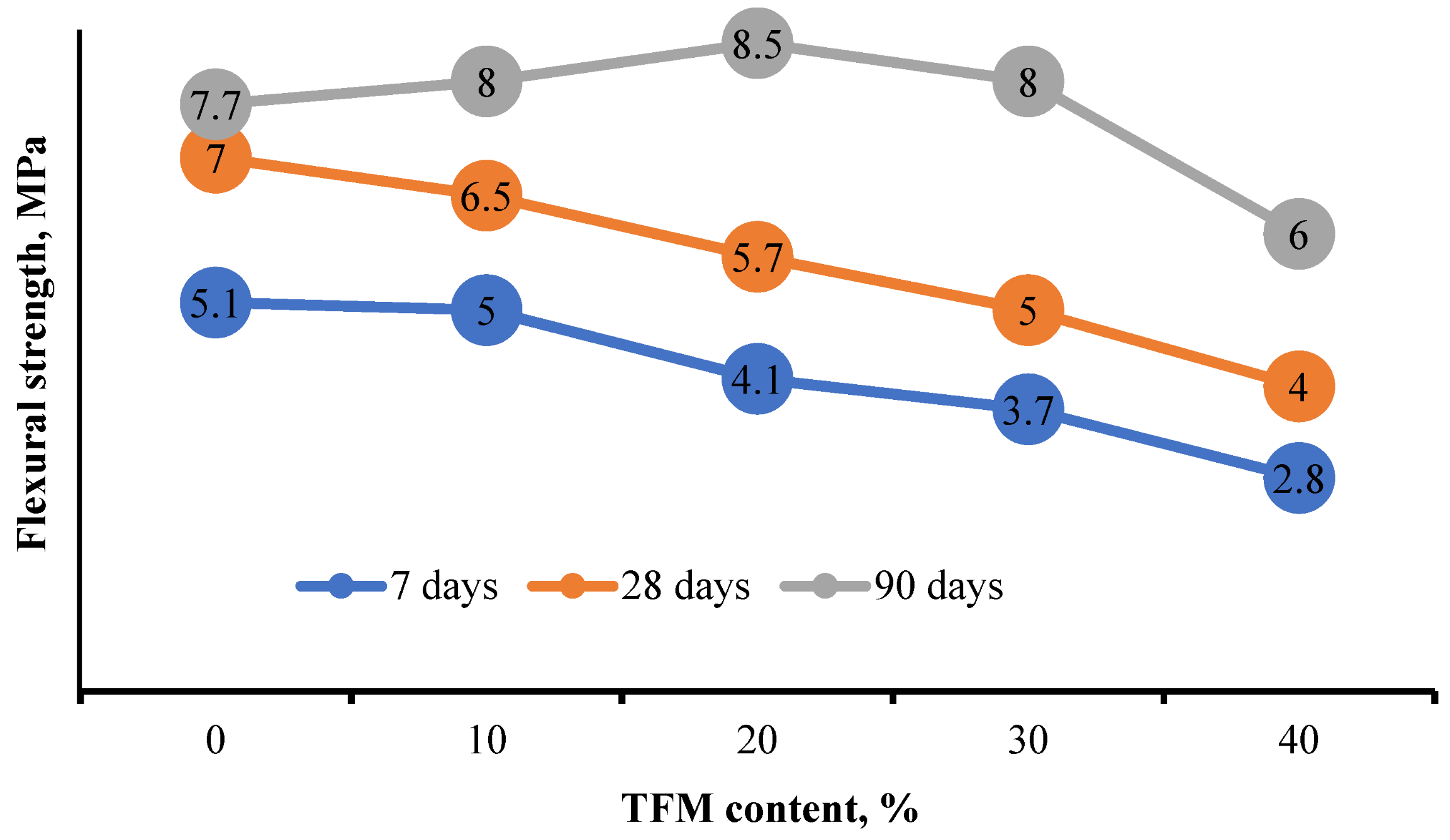
| Content of Oxides, % | Mineral Wool | Microsilica | Portland Cement |
|---|---|---|---|
| SiO2 | 44.11 | 91.5 | 21.2 |
| Al2O3 | 12.26 | 0.2 | 5.4 |
| Fe2O3 | 9.44 | 0.7 | 3.2 |
| CaO | 16.00 | 0.4 | 63.8 |
| MgO | 13.19 | 1.5 | 2.0 |
| K2O + Na2O | 2.97 | 1.9 | 0.8 |
| other | 2.27 | 3.8 | 3.6 |
| Specific surface area, m2/kg | 200 | 22500 | 364 |
| Mix ID | Mineral Wool Content, wt.% | Water, L/m3 | Cement, kg/m3 | Micro- Silica, kg/m3 | Mineral Wool, kg/m3 | Sand, kg/m3 | Super- Plasticizer, % |
|---|---|---|---|---|---|---|---|
| 1 | 0 | 218.2 | 545.5 | 54.5 | 0.0 | 1500 | 1 |
| 2 | 10 | 218.0 | 490.9 | 49.1 | 54.6 | 1498.5 | 1 |
| 3 | 20 | 217.8 | 436.3 | 43.6 | 109.2 | 1496.9 | 1 |
| 4 | 30 | 217.6 | 381.7 | 38.2 | 163.8 | 1495.4 | 1 |
| 5 | 40 | 217.4 | 327.1 | 32.7 | 225.6 | 1494 | 1 |
| Percentile, % | Diameter, µm | ||
|---|---|---|---|
| Non-Grinded | Grinded 5 min | Grinded 10 min | |
| 10 | 11.05 | 5.55 | 2.78 |
| 50 | 91.09 | 50.36 | 14.12 |
| 90 | 240.94 | 218.77 | 44.53 |
| Indicator | Finely Ground Mineral Components | ||
|---|---|---|---|
| Cement | Microsilica | TFM | |
| Specific surface area by a PSH-2 device, m2/kg | 500 | 1500 | 500 |
| Specific surface area by Sorbi-M device (4-point BET method), m2/g | 3.80 | 21.02 | 2.56 |
| Pore volume with R < 19.4 nm, cm3/g | 0.014 | 0.13 | 0.023 |
| Mix ID | Slump, cm | Slump Flow, cm | Fresh Density (ρ), kg/m3 | ∆ρ/%TFM | Density at 28 Days (ρ28), kg/m3 | ∆ρ28/%TFM |
|---|---|---|---|---|---|---|
| 1 | 20 | 51 | 2341 | - | 2321 | - |
| 2 | 20 | 50 | 2334 (−0.3%) | −0.03% | 2315 (−0.3%) | −0.03% |
| 3 | 20 | 48 | 2326 (−0.6%) | −0.03% | 2308 (−0.6%) | −0.03% |
| 4 | 20 | 46 | 2320 (−0.9%) | −0.03% | 2303 (−0.8%) | −0.02% |
| 5 | 18 | 46 | 2320 (−0.9%) | −0.02% | 2304 (−0.7%) | −0.02% |
Publisher’s Note: MDPI stays neutral with regard to jurisdictional claims in published maps and institutional affiliations. |
© 2022 by the authors. Licensee MDPI, Basel, Switzerland. This article is an open access article distributed under the terms and conditions of the Creative Commons Attribution (CC BY) license (https://creativecommons.org/licenses/by/4.0/).
Share and Cite
Klyuev, S.; Fediuk, R.; Ageeva, M.; Fomina, E.; Klyuev, A.; Shorstova, E.; Sabitov, L.; Radaykin, O.; Anciferov, S.; Kikalishvili, D.; et al. Technogenic Fiber Wastes for Optimizing Concrete. Materials 2022, 15, 5058. https://doi.org/10.3390/ma15145058
Klyuev S, Fediuk R, Ageeva M, Fomina E, Klyuev A, Shorstova E, Sabitov L, Radaykin O, Anciferov S, Kikalishvili D, et al. Technogenic Fiber Wastes for Optimizing Concrete. Materials. 2022; 15(14):5058. https://doi.org/10.3390/ma15145058
Chicago/Turabian StyleKlyuev, Sergey, Roman Fediuk, Marina Ageeva, Ekaterina Fomina, Alexander Klyuev, Elena Shorstova, Linar Sabitov, Oleg Radaykin, Sergey Anciferov, Diana Kikalishvili, and et al. 2022. "Technogenic Fiber Wastes for Optimizing Concrete" Materials 15, no. 14: 5058. https://doi.org/10.3390/ma15145058
APA StyleKlyuev, S., Fediuk, R., Ageeva, M., Fomina, E., Klyuev, A., Shorstova, E., Sabitov, L., Radaykin, O., Anciferov, S., Kikalishvili, D., de Azevedo, A. R. G., Vatin, N. I., & Amran, M. (2022). Technogenic Fiber Wastes for Optimizing Concrete. Materials, 15(14), 5058. https://doi.org/10.3390/ma15145058










